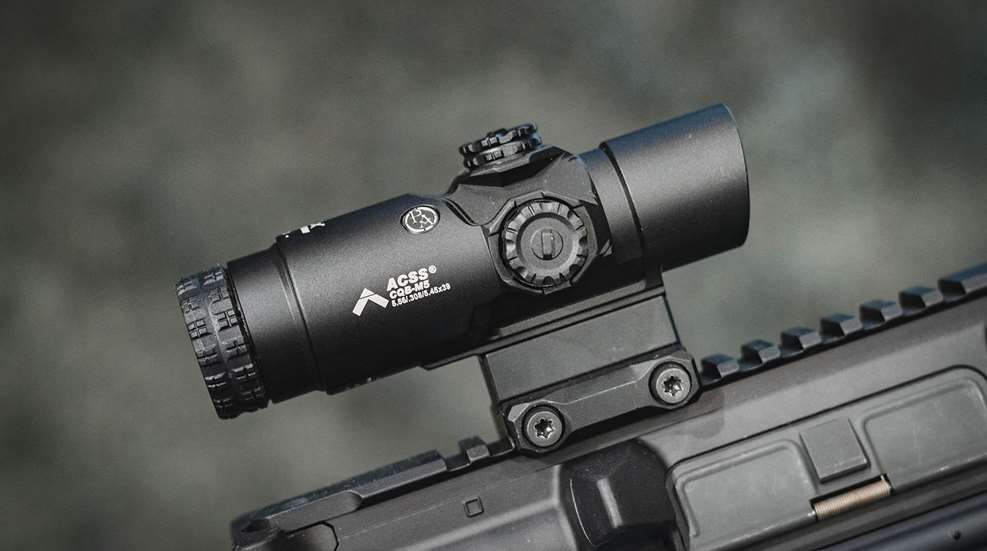
When it comes to prismatic sights for modern sporting rifles, in the past, options were fairly limited and tended to hang on the costly side of the price spectrum. While several companies offer optics with noteworthy performance and unsurpassed glass clarity, the price point has often warded off budget-conscious buyers. Over the past several years, however, the optic market has seen an influx of new, and more economic, prism sight options for tactical rifles. One that recently caught my eye is the Primary Arms GLx 2x prism scope, which offers several useful features built in, all for under $400.
Primary Arms has made a name for itself by providing capable red-dot and magnified optics at a price point considerably lower than what would be expected in the past. It offers fixed-power prism sights as well, with several options in its lower SLx category. The GLx 2x, on the other hand, is a part of the company’s mid-tier line. It has been on the market for a few years now, receiving notice along the way. In that time, Primary Arms has expanded the capabilities of the optic, with several new reticle calibrations.
 A graphic of what the ACSS CQB-M5 and ranging bars underneath look like through the GLx 2x. Photo courtesy of Primary Arms.
A graphic of what the ACSS CQB-M5 and ranging bars underneath look like through the GLx 2x. Photo courtesy of Primary Arms.
The GLx 2x uses the ACSS reticle for which Primary Arms has earned regard, and it is a key part of what makes the company's optics stand out from others at the price point. The ACSS CQB-M5 reticle found in the objective of the GLx 2x consists of a chevron central aiming point, surrounded by a large horseshoe. This horseshoe helps to quickly draw the eye to the center of the objective, in a manner similar to the ring used in EOTech’s reticles. Beneath the chevron are two additional dots, which serve as bullet-drop compensation (BDC) holds. Even further beneath that are several lines, which act as ranging bars. The ranging bars are sized to estimate the range of a 5’ 10” tall, 18” wide, man-sized target from 300 to 500 yards.
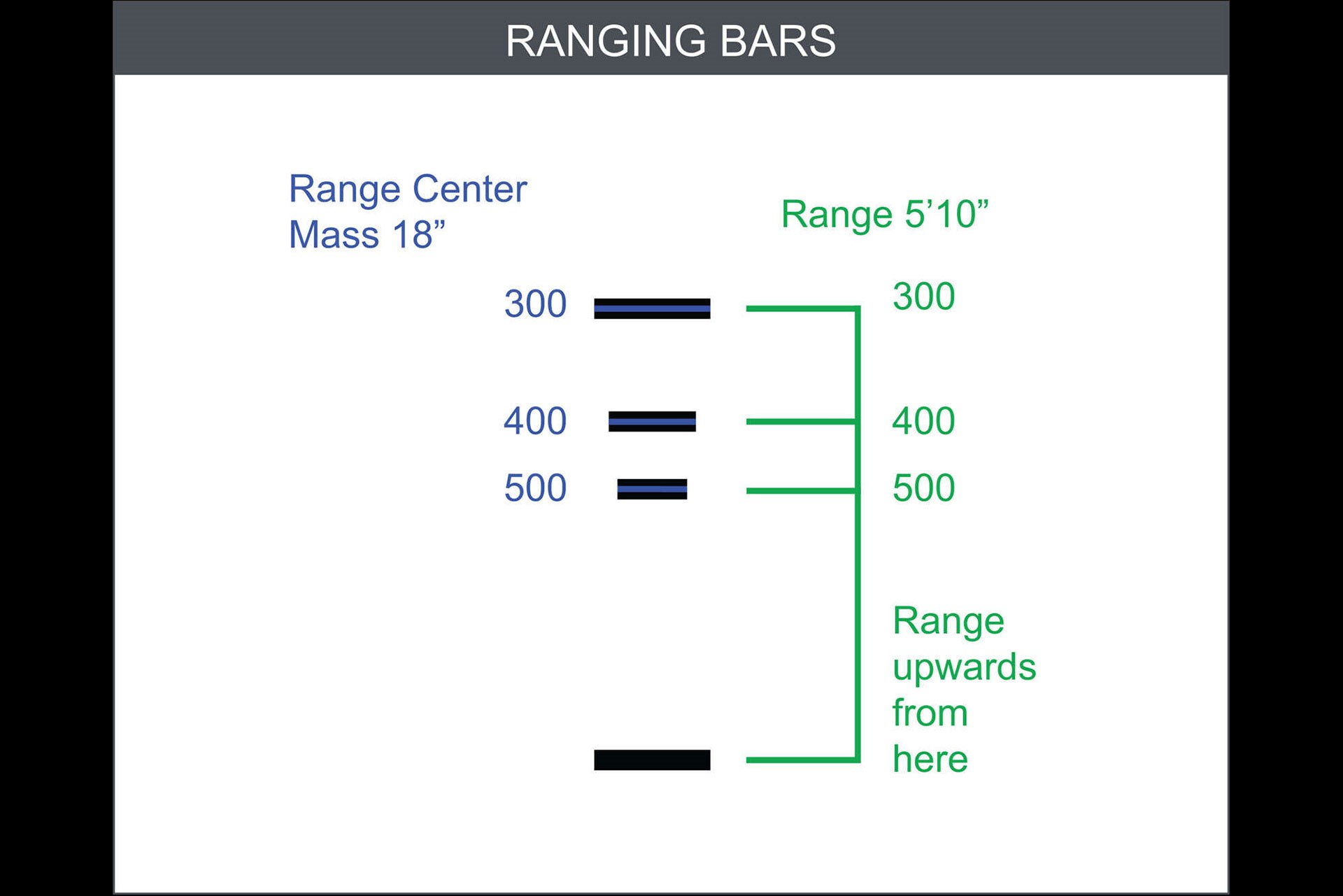 How the ranging bars beneath the reticle function, with the blue numbers representing the value in yards. Photo courtesy of Primary Arms.
How the ranging bars beneath the reticle function, with the blue numbers representing the value in yards. Photo courtesy of Primary Arms.
Yet that’s only part of the reticle’s capability, as it can also be used with, and is offered in different calibrations for, several different calibers. Primary Arms currently offers the GLx 2x in three different calibrations: a 5.56 NATO, .308 Win. and 5.45x39 mm version; a 7.62x39 mm and .300 Blackout version; and a 9 mm version. All three of these options are identical in terms of function and specifications, other than the BDC. This allows the GLx 2x to be paired with a wide number of rifles and large format pistols, while still allowing accurate use of the BDC. The reticle of the GLx 2x can also be partially illuminated and is completely etched into the glass, which provides a permanent aiming point, even without power.
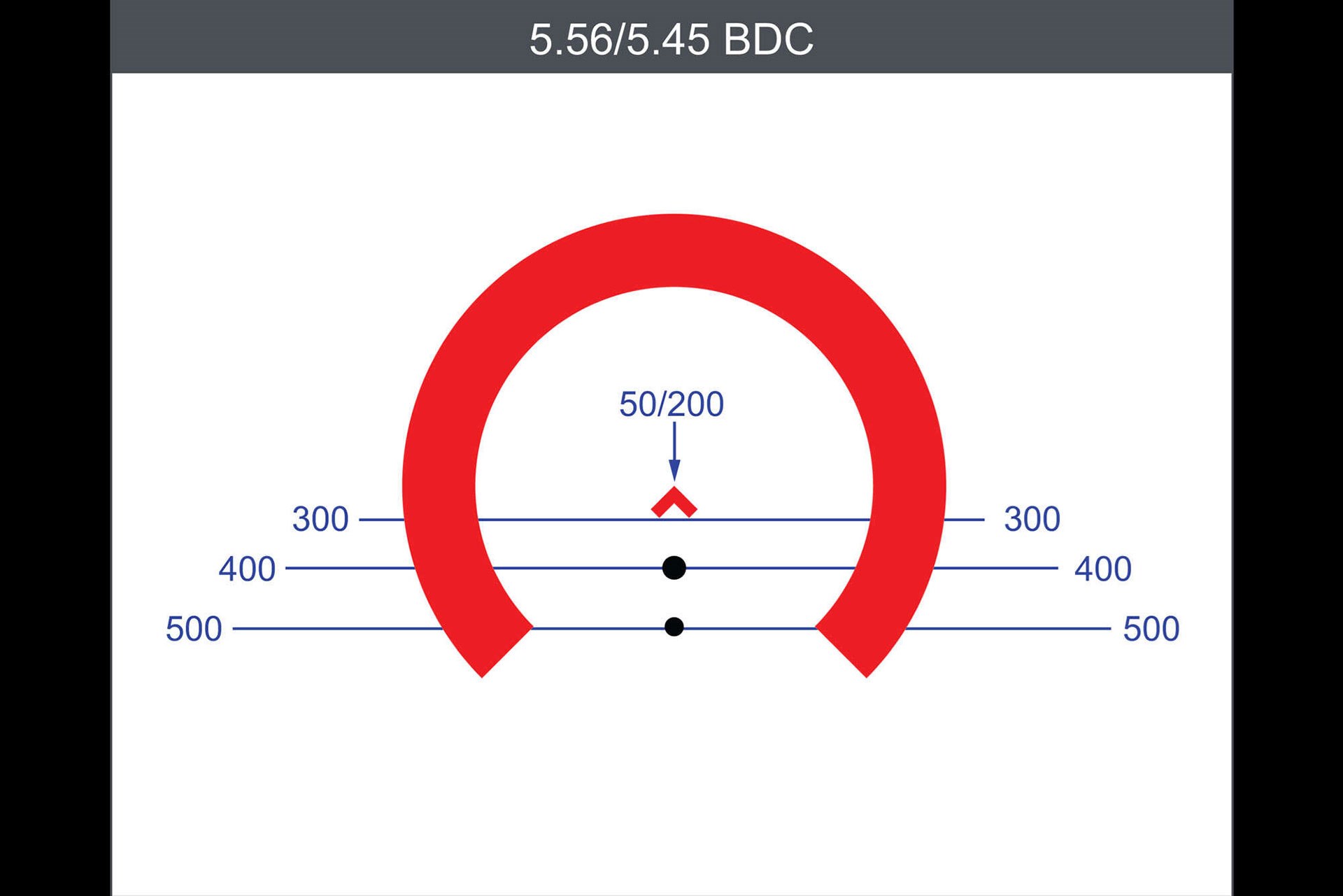 The calibration of the ACSS CQB-M5 BDC for 5.56 NATO and 5.45x39 mm carbines, with the values represented in yards. Photo courtesy of Primary Arms.
The calibration of the ACSS CQB-M5 BDC for 5.56 NATO and 5.45x39 mm carbines, with the values represented in yards. Photo courtesy of Primary Arms.
Powered by a single CR2032 battery housed within a rotating brightness adjustment turret on the left side of the scope housing, the GLx 2x has 11 brightness settings. There are even two dedicated night vision settings incorporated. Only the chevron and horseshoe illuminate, with both lighting up red in color, and the illumination is advertised to be daylight bright. This scope is also touted to have a 20,000-hour battery life, thanks to Primary Arms’ built-in AUTOLIVE feature. Sensitive to motion, the AUTOLIVE feature will turn off the illumination of the optic after sitting still for a few minutes and will also re-illuminate the reticle to whatever brightness setting the turret is rotated to once it detects motion again.
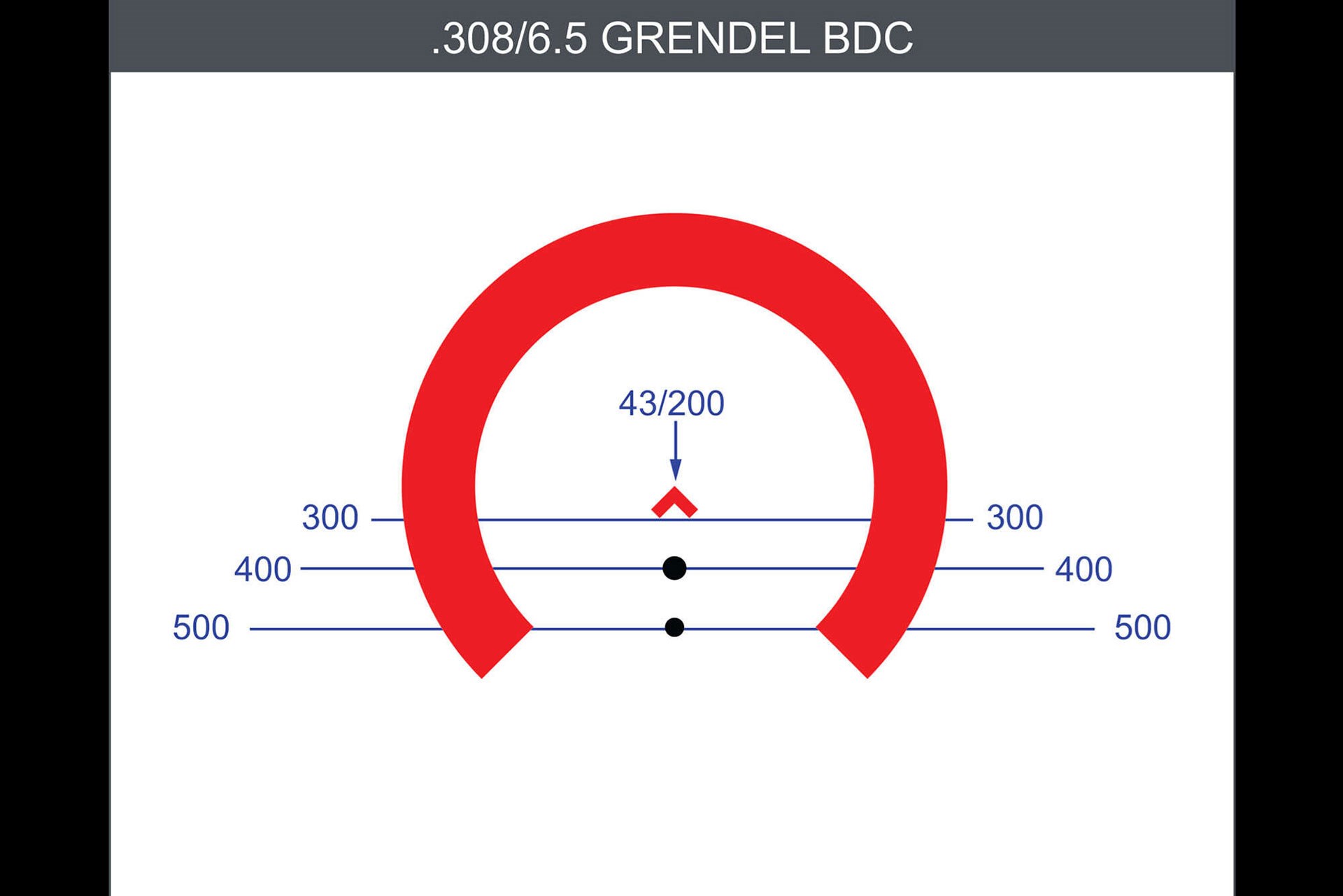 The BDC calibration of the same ACSS CQB-M5 reticle for .308 Win. and 6.5 mm Grendel carbines. Photo courtesy of Primary Arms.
The BDC calibration of the same ACSS CQB-M5 reticle for .308 Win. and 6.5 mm Grendel carbines. Photo courtesy of Primary Arms.
Despite just being 2x, the magnification pairs well with the dual functionality of the ACSS for both range and closer targets. The glass quality is good, offering a clear sight picture for the price point with minimal haze or distortion. The front objective offers a 42’ field of view at 100 yards, and the exit pupil is 12 mm. One of the most noteworthy bits about the objective its forgiving eye relief, which is listed as 3.5” but is usable even past that. There is even and adjustable diopter included at the rear, which allows users to adjust the objective for astigmatism issues, a nice feature that isn’t found even on similar scopes three times the price. As an aside, Primary Arms also offers a honeycomb anti-reflection device for $40, which screws into the front of the scope’s objective. This attachment is made to hide glare from the front objective lens, and secures itself with the use of a rubber O-ring.
Adjustments are made through the use of two capped turrets, with elevation on the top and windage on the right side of the scope body. The screw-on protective caps have flat-head tool segments machined onto their tops, which allow them to interface with the adjustment turrets for easier adjustments, though the rim of a cartridge or other impromptu tools can also be used. The adjustments values for windage and elevation are 0.25 m.o.a., with both having a total adjustment range of 40 m.o.a.
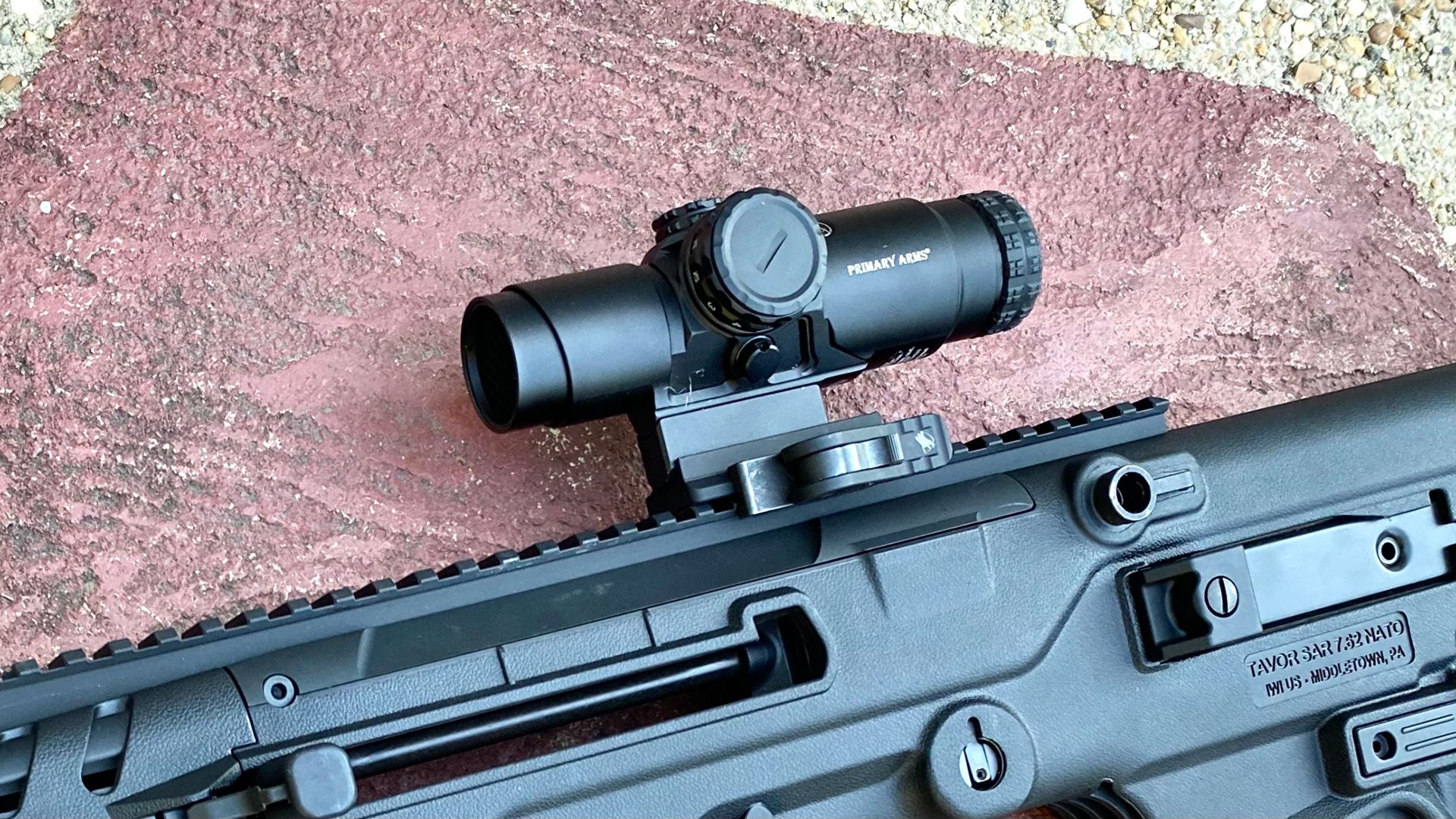 The GLx 2x with Primary Arms anti-reflection device installed, as well as an American Defense Manufacturing AD-B2 QD mini ACOG mount and factory-provided raiser, on an IWI Tavor 7.
The GLx 2x with Primary Arms anti-reflection device installed, as well as an American Defense Manufacturing AD-B2 QD mini ACOG mount and factory-provided raiser, on an IWI Tavor 7.
The body of the GLx 2x is made from aluminum, with the housing being machined from a single piece, and wears a black hardcoat-anodized finish. It is relatively compact in size at just 5.3” long, and weighs in at 11 ozs. Despite the relatively low weight, the GLx 2x is robust in its construction, and is also rated to be shock- and waterproof. At the base of the scope body is another feature that sticks out: the mounting interface. The GLx 2x is machined with a footprint that is compatible with smaller Trijicon ACOG-style mounts, of which there are a wide range of styles available on the market. An aluminum Picatinny rail mount is included in the box with the GLx from the factory, along with three different risers. This factory mount, while not having a quick-detach feature like some of the ACOG-style mounts, is lightweight, well-constructed and a perfectly serviceable, should the user not see the need to spend extra on a different mount.
In my own experience testing out the GLx 2x, it pleasantly surprised me with its features and construction for the price. The ACSS reticle design is well thought out and very intuitive, providing several useful tools integrated, all without creating an overly busy sight picture. However, I found at times that the illumination could be washed out on lighter backdrops on a bright day, even when set to the brightest setting. This might be an issue for some who live in more arid areas that get more lighting and have bright backdrops, but the fact that the entire reticle is etched negates this, as even with a brighter backdrop, the reticle can still be plainly seen, just black in color. The adjustments of the brightness turret are distinct and firm, along with the click adjustments for the windage and elevation caps. While I never had the opportunity to test out the BDC myself for the different calibrations, Primary Arms provides several illustrations for such on its website, which is a helpful resource.
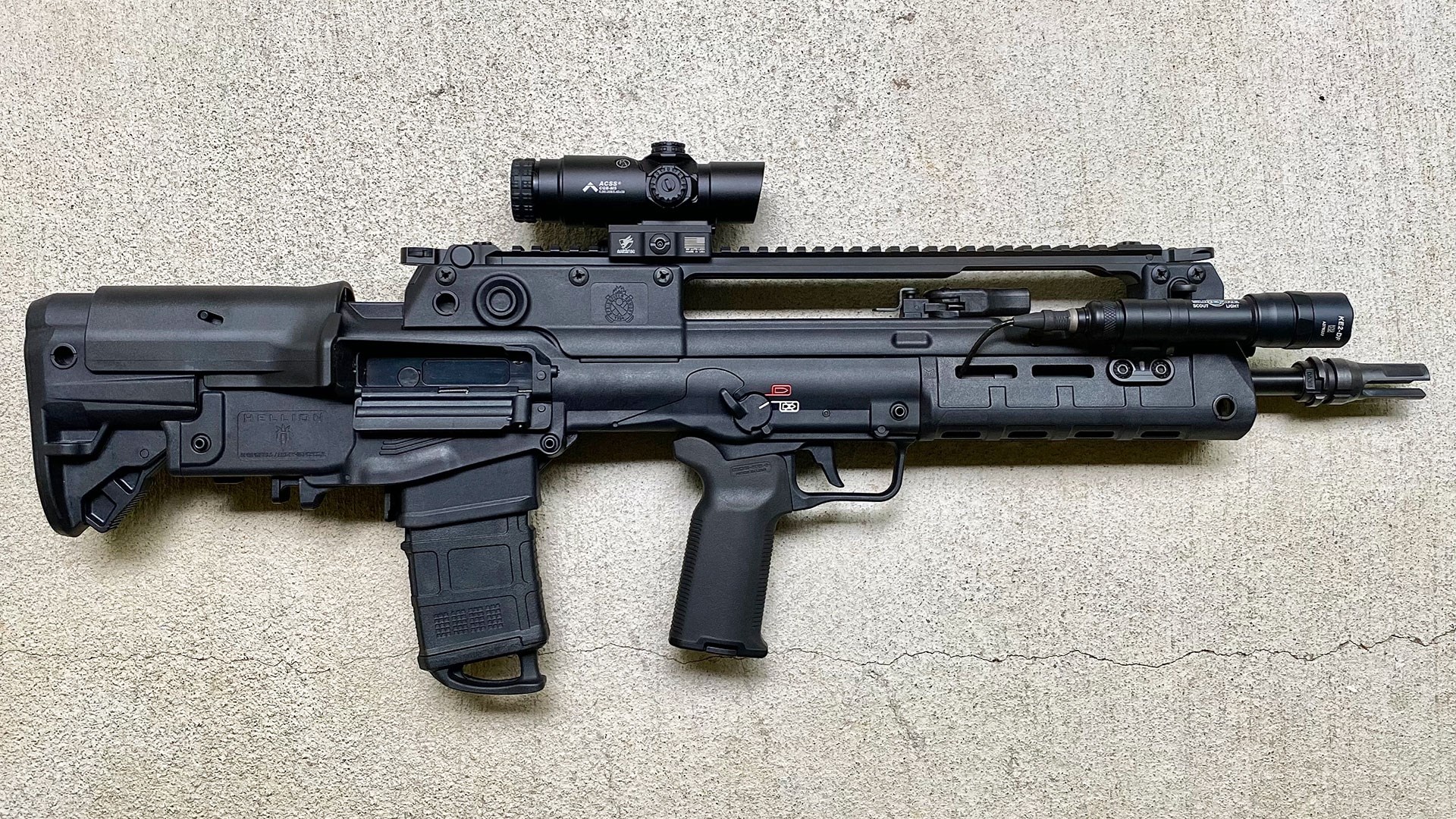 The GLx 2x, without risers and American Defense Manufacturing AD-B2 mount paired with the author's Springfield Armory Hellion.
The GLx 2x, without risers and American Defense Manufacturing AD-B2 mount paired with the author's Springfield Armory Hellion.
The ability of the GLx 2x to attach to ACOG-style mounts is a very attractive feature in my eyes, as it gives a wide range of different mounts to choose from. While all have their merits, a personal favorite of mine is the American Defense Manufacturing AD-B2 modular base with a single throw lever, to which the GLx attached without issue. I also found, as an added bonus, that the included risers that come with the GLx 2x can be used in tandem with the aftermarket ACOG-style mounts, as they use the same footprint. Most of my use of it was paired with a Springfield Armory Hellion, for which I found the GLx 2x to be a great option for, with its ability to be mounted lower to the rail and the benefits of the forgiving eye relief. Though, with these same features in mind, the GLx 2x would pair well with most any modern sporting rifle platform. And of course, there is the price point of it, at $370, which is hard to bat an eye at for an optic with such capability. To learn more about the GLx 2x prism scope and the three different caliber calibrations offered, visit primaryarms.com.




































